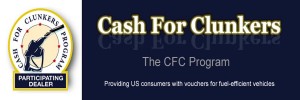
More than 10% of the $1 billion set aside for the Cash-for-Clunkers was paid out less than a week into the program.
Anyone who wondered whether the cash-for-clunkers program would actually spur demand in the moribund U.S. auto market no longer need worry. The $1 billion federal pot designed to get motorists to trade in their old, inefficient vehicles for newer, high-mileage models has received a roaring welcome from consumers, carmakers as diverse as Ford and Subaru hinting July could be their strongest month in quite some time.
Less than a week after the program officially began, federal officials reported that a full 10% of the money set aside for what is formally known as the Car Allowance Rebate System, or CARS, has already been paid out. That’s leading some lawmakers to question whether more money might be set aside by Congress.
“Having this program last for only a few weeks would limit (its) potential and disenfranchise a number of consumers who wish to take advantage of the program,” Candice Miller, a U.S. Congresswoman from suburban Detroit, wrote her colleagues, adding that, “The program has the possibility to truly jumpstart our economy.”
 It’s certainly helping kick-start investor interest in the industry. Ford Motor Co. shares surged as high as $7.48, today, before settling back to close at $7.39, the highest end-of-day figure in a year.
It’s certainly helping kick-start investor interest in the industry. Ford Motor Co. shares surged as high as $7.48, today, before settling back to close at $7.39, the highest end-of-day figure in a year.
That optimism reflects upbeat news that Ford sales were already heading for a strong month, even before the Clunkers program was launched, and have only grown stronger since.
“I think from an economic standpoint as well as an auto standpoint most indicators point to the fact that worst is probably behind us,” said George Pipas, chief sales analyst at Ford, adding that indications are that for the first time in months, overall U.S. car sales, for July, should exceed an annualized rate of 10 million.
So far, this year, auto sales are down about 47% from their peak, early in the decade. The industry hasn’t seen the current volumes since the country was last in a deep, deep recession, back in 1980.
But Ken Czubay, the automaker’s sales and marketing chief, warned the Detroit Free Press, that the CARS program likely won’t make it – without additional funding – through its originally-planned termination, in November.
“It’s a huge success,” Czubay told the paper. “But if you are planning on buying on Halloween night, I would probably move that forward.”
Ford isn’t the only automaker reporting a positive impact from CARS. A spokesman for Subaru of America issued a preliminary announcement suggesting the carmaker, “is expected to report a strong July close and an increase over July 2008,” when it announces monthly sales, on Monday.
Congress spent months debating the merits of a program aimed at encouraging car sales – and getting older, low-efficiency vehicles off the road. Similar programs have proven extremely successful in other parts of the world, notably including Germany, where the auto market has roared back to life on the back of consumer incentives.
Early efforts to focus the U.S. program on building demand for domestic products were quickly abandoned. The eventual resolution has focused on vehicles less than 25 years old, and provides two levels of cash vouchers, $3,500 and $4,500, depending on the amount mileage is improved through the trade-in – no matter what brand vehicle is involved.
But where proponents had been hoping for a $4 billion package, the compromise legislation set the limit at just $1 billion, critics contending the budget deficit simply didn’t justify yet another big government spending program, no matter what the potential payoff.
Ironically some analysts believe the CARS program may have actually hurt the market, at least in June, where an early increase in auto sales went south as it appeared Congress would pass some sort of Clunkers program. Many potential buyers apparently didn’t want to jump the gun and lose out on getting as much as $4,500 more for their trade-in.
How much impact CARS will have on the environment isn’t easy to calculate, though a study by the South Korean carmaker, Hyundai, estimated that by the time the money runs out, the more fuel-efficient models put on the road will decrease U.S. fuel consumption by 275 million gallons a year. At current pump prices, the automaker estimated that would save owners $680 million annually.
Another unanswered question is what happens once the money does run out, whether or not the CARS program gets another dose of federal cash. Over the years, automakers have learned that their high-dollar incentive programs have a tendency to “pull forward” purchases. In other words, those who might have waited a few weeks or months, decided to move back into the market early. But when the programs run out, that leaves a dearth of buyers and a sudden decline in sales.
Should the same thing happen with CARS, that could throw the industry into turmoil, forcing another round of production cuts, plant shutdowns and layoffs, rather than stimulating the recovery the program’s sponsors had hoped for.
